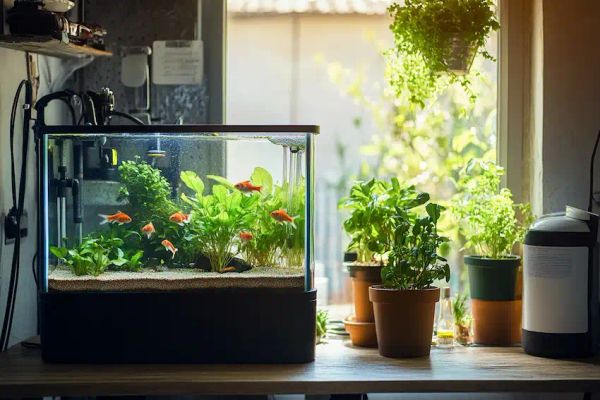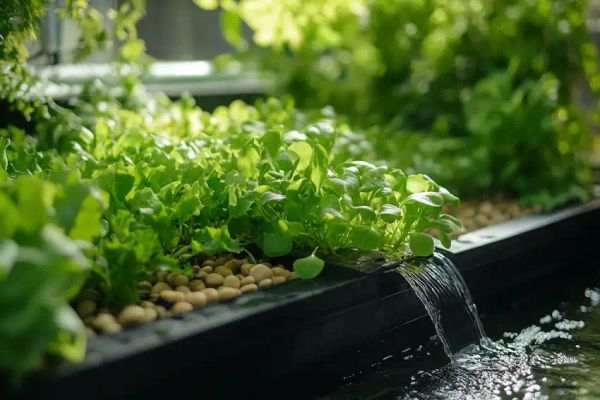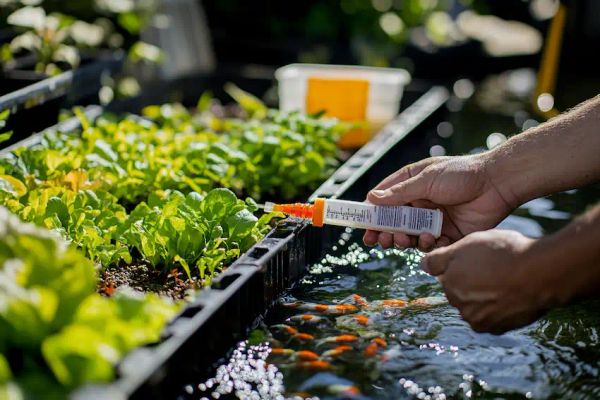Aquaponics is an exciting and eco-friendly way to grow your own food right in your backyard or indoor space. This revolutionary method combines raising fish (aquaculture) with growing plants in water (hydroponics) in a single, closed-loop system. It’s a sustainable approach that benefits both the plants and the fish, creating a symbiotic relationship where each element supports the other. In this friendly guide, we’ll walk you through the steps of setting up your own aquaponics system, from choosing the right location to maintaining a thriving ecosystem.
Choose the Perfect Spot
When it comes to the success of your aquaponics system, the location is key. Here are some factors to consider:
Light Requirements: Make sure the location receives enough natural light for the plants, as they need 6-8 hours of sunlight daily. If natural light is limited, you can use grow lights to provide the necessary light spectrum for plant growth.
Temperature and Climate: The location should have a stable temperature that’s suitable for both the plants and the fish. Extreme temperatures can stress the fish and hinder plant growth. If your system is indoors, consider a climate-controlled area. If it’s outdoors, think about shade or insulation during extreme weather.
Power and Water Access: Position your system near a reliable power source for running pumps, lights, and possibly heaters. Also, ensure easy access to water for filling and topping up the fish tank.
Space Considerations: Depending on the size of your system, choose a location that allows easy access for maintenance and harvesting. Vertical systems can save space and are ideal for smaller areas.
Set Up Your Fish Tank

The fish tank is the heart of your aquaponics system, and selecting the right tank is vital. Here are some tips:
Tank Size: Consider the available space and the type of fish you plan to raise. For beginners, a 100-200 gallon tank is ideal, as it’s easier to maintain water quality in larger volumes. Smaller tanks (20-50 gallons) are suitable for indoor systems but require more frequent monitoring.
Material: Choose a tank made from food-safe materials that won’t harm the fish. Plastic tanks are popular because they are lightweight and durable.
Location: Place the tank on a sturdy, level surface that can support the weight of the water-filled tank. Ensure easy access for feeding, cleaning, and monitoring.
Fish Species: Select fish that are compatible with the climate and water conditions in your area. Common choices include tilapia, catfish, goldfish, and koi. If you live in a colder climate, consider cold-water species like trout or perch.
Install a Grow Bed
The grow bed is where your plants will thrive and play a crucial role in filtering the water. Here’s what you need to know:
Positioning: Place the grow bed above the fish tank so gravity can return filtered water to the tank. This setup simplifies plumbing and ensures efficient water flow.
Media: Fill the grow bed with a suitable growing medium that supports plant roots and facilitates nutrient exchange. Expanded clay pebbles, gravel, and lava rock are popular choices.
Size and Depth: The size of the grow bed should be proportionate to the fish tank. Aim for a grow bed that’s about half the size of the fish tank. The depth should be at least 12 inches to allow root development and proper filtration.

Connect a Water Pump
A reliable water pump is essential for circulating water between the fish tank and the grow bed. Here’s what you need to do:
Pump Selection: Choose a pump that can circulate the entire volume of water in your fish tank at least once per hour. This ensures continuous nutrient delivery to the plants and proper oxygenation for the fish.
Plumbing: Use food-grade tubing to connect the pump to the grow bed. The pump will push water from the fish tank to the grow bed, where the plants absorb nutrients. Then, the filtered water will return to the fish tank. Including a bell siphon or overflow drain helps regulate water levels and prevent flooding.
Backup Power: Consider installing a battery backup or solar power system to keep the pump running during power outages. This is crucial for the health of your fish.
Cycle the System
Before adding fish, it’s important to establish beneficial bacteria in the system. Follow these steps:
Understanding Cycling: Cycling is the process of building up colonies of nitrifying bacteria that convert toxic ammonia into less harmful nitrites and nitrates. These nitrates serve as nutrients for the plants.
Fishless Cycling: To cycle your system without fish, add an ammonia source to the fish tank, such as pure ammonia or decomposing organic matter. Use a water testing kit to monitor ammonia, nitrite, and nitrate levels. The cycling process takes 4-6 weeks.
Fish-In Cycling: If you prefer to cycle with fish, start with a small number of hardy fish and closely monitor water parameters. Be prepared to do partial water changes to ensure safe levels of ammonia and nitrites for the fish.
Beneficial Bacteria: Promote bacterial growth by maintaining a water temperature between 77°F and 86°F (25°C and 30°C) and ensuring adequate oxygenation through aeration or water movement.
Add Fish and Plants
Once the system is cycled, it’s time to introduce your fish and plants:
Fish Introduction: Gradually acclimate the fish to their new environment by floating their bag in the fish tank for about 15-20 minutes to equalize the temperature. Then, slowly release the fish into the tank.
Planting: Choose plants that thrive in the same conditions as your fish. Leafy greens like lettuce, spinach, and kale are ideal for beginners. Other suitable plants include herbs, tomatoes, peppers, and strawberries.
Spacing: Leave enough space between plants in the grow bed for air circulation and root growth. Start with seedlings or cuttings instead of seeds, as they establish faster in the aquaponics system.
Monitor and Maintain
Regular monitoring and maintenance are essential for a healthy aquaponics system:
Water Quality: Test water parameters regularly, including pH and ammonia, nitrite, and nitrate levels. Ideal pH levels for aquaponics range from 6.8 to 7.2. Adjust pH using natural buffers like crushed eggshells or peat moss.
Feeding: Feed the fish a balanced diet, but avoid overfeeding, as excess food can decay and pollute the water. Remove any uneaten food after 30 minutes.
Plant Health: Monitor plant growth and health, looking for signs of nutrient deficiencies or pests. Prune plants regularly to promote growth and prevent overcrowding.
System Maintenance: Clean the grow bed periodically to remove debris or dead plant material. Check the pump and plumbing for blockages or leaks, and ensure that all equipment is functioning properly.
Harvesting: Harvest plants regularly to encourage continuous growth and remove fish waste from the tank as needed. Regular harvesting helps maintain a balanced ecosystem.

Benefits of Aquaponics
Aquaponics offers numerous benefits that make it a fantastic choice for growing your own food:
Sustainability: Aquaponics uses minimal water and eliminates the need for chemical fertilizers, making it an eco-friendly method of food production.
Space Efficiency: Aquaponics systems can be set up in small spaces, making them ideal for urban environments or areas with limited outdoor space.
Fresh Produce and Fish: With aquaponics, you can enjoy fresh, organic produce and raise fish in your own home, providing a reliable source of healthy food.
Challenges and Considerations
While aquaponics is a sustainable and efficient way to grow plants and raise fish, there are a few things to keep in mind:
Initial Setup Costs: The initial setup costs for tanks, pumps, and other equipment can be high, although aquaponics can save you money in the long run.
Learning Curve: Aquaponics requires a basic understanding of water chemistry and system maintenance. Beginners may face a learning curve as they get used to managing the system.
Dependence on Electricity: Aquaponics systems rely on electricity to run pumps and lights. It’s important to have backup options in case of power outages.
Start Your Aquaponics Journey Today
Aquaponics offers a unique and sustainable way to grow your own food, combining the best aspects of aquaculture and hydroponics into one harmonious system. By following the steps outlined in this guide, you can create a thriving aquaponics system in your own backyard or indoor space. Enjoy the rewards of fresh food and the satisfaction of nurturing a sustainable ecosystem. Happy gardening!



